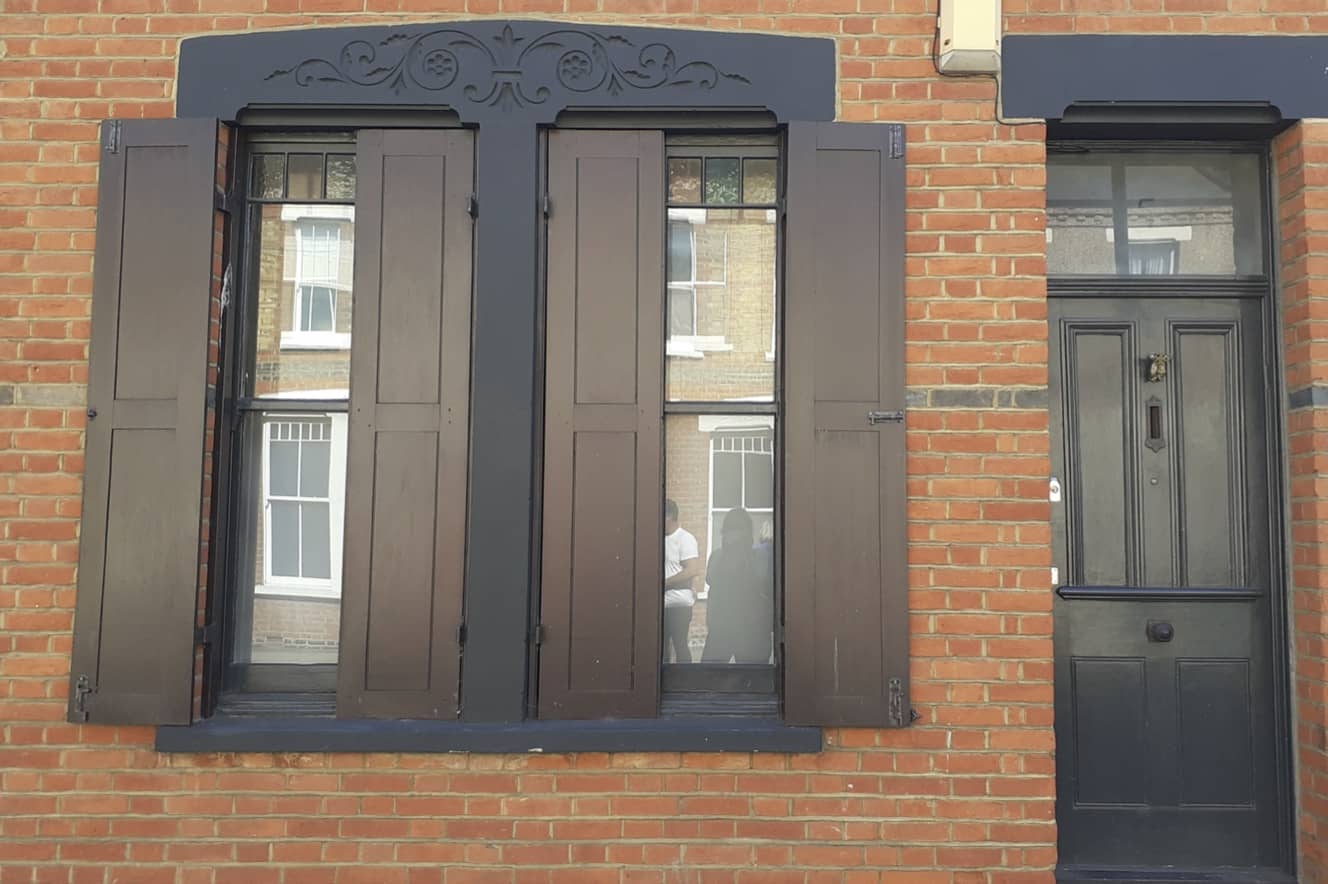
www.buildingsandcities.org/insights/commentaries/practical-approaches-cooling.html
Practical Approaches to Cooling: A UK Perspective

Reducing the need for air conditioning is necessary and feasible. Passive measures for cooling are advantageous.
Julie Godefroy (CIBSE and Julie Godefroy Sustainability) and Anastasia Mylona (CIBSE) respond to the Buildings & Cities special issue 'Alternatives to Air Conditioning: Policies, Design, Technologies, Behaviours'. Proactive options already exist to adapt buildings to hotter summers and extreme events. A balanced approach to risk, complexity and detail is called for.
The editorial (Ford et al. 2022) of this timely special issue clearly states the reasons to limit reliance on air conditioning (AC): limiting the risk of fuel poverty, reducing cooling needs, improving resilience to failure of the plant or electricity grid, and avoiding the vicious circle of heat rejection from cooling plant which in turns contributes to the Urban Heat Island (UHI).
As electricity systems decarbonise, there is a risk that AC may be perceived as an easy low-carbon solution to improve comfort. This mindset must be avoided because:
- The decarbonisation of electricity systems will require a huge increase in zero carbon generation capacity. This will be achieved faster and at lower costs if coupled with energy efficiency (National Grid 2022).
- Peak demand becomes increasingly relevant as our society electrifies. An increased reliance on AC will increase pressure on local or national grids, due to peak cooling demand.
The range of solutions to avoid or reduce the need for AC is reasonably well established. These include passive design solutions at the building level to protect from excessive solar gains, good ventilation strategies (e.g. natural ventilation: dual aspect dwellings and the use of atria and courtyards; ceiling fans to increase air movement), urban design solutions to limit the Urban Heat Island (UHI) (e.g. integrating blue-green infrastructure) and behavioural approaches to adaptive comfort.
While passive approaches are well established in other climates from which valuable lessons can be gained, as illustrated in this SI, they do require some adaptation to the UK's design and cultural context.1
A balanced approach to risk
Comfort criteria and modelling approaches are key to inform the need for design measures. They must achieve a careful balance.
If an overly optimistic approach is taken and the methodologies under-estimate the need for design intervention (whether passive or active), then this will lead to discomfort, health risks, and a possible future installation of AC.
If an overly cautious approach is taken, designers could conclude that AC is needed, with a number of detrimental consequences:
- Once the decision has been made to incorporate cooling, there is less incentive for designers to incorporate passive means: this can lead to higher demand and, for those who cannot afford to run the system, more exposure to discomfort and health risks. Regulation has a role to mandate passive means and reduce cooling demand, regardless of what mechanical plant is installed.
- Over-cautious summer comfort criteria could lead to design approaches that reduce passive solar gains in winter, when they would be useful. While some design strategies can easily deal with both, this does require attention.
- Evidence from other countries suggests that once AC is installed it raises inhabitants' expectations for a more tightly controlled environment. This leads to increased AC use (and energy demand) when passive means and adaptive measures would have sufficed - as illustrated by Murtagh et al. (2022) in this special issue. Criteria which would over-cautiously lead to the installation of AC can have unintended negative consequences.
This context is one of the drivers behind the creation a few years ago of CIBSE TM59, which proposes thermal comfort criteria and a modelling approach for new housing at the design stage. It is also why the TM59 criteria are now being reviewed by CIBSE. In particular, the criteria for temperatures in bedrooms are notoriously difficult to achieve, especially in Greater London. From the limited evidence available at the time of the original TM59, this cautious approach is justified by the fact that overheating that prevents sleep is particularly detrimental for health. CIBSE are now reviewing whether the criteria (i.e. maximum temperature, as well as duration and frequency of occurrence) would benefit from fine tuning, based on the work of Loughborough University (Lomas et al. 2021) on the Energy Follow Up Survey data and additional evidence from temperatures and user feedback in homes.
A balanced approach to complexity and detail
Methods which are overly simple or generic help raise awareness of general principles, and possibly assist designers at the very early stages. However, practitioners require project-specific solutions that balance diverse requirements of a good space (e.g. summer and winter comfort, daylight and views, and energy use).
On the other hand, detailed and complex methods risk only being used by the few projects which can afford it or are mandated to have it (e.g. the London Plan). Furthermore, detailed tools risk not being used early on, when strategic design decisions with significant influence on building performance are being made e.g. orientation, or whether dwellings can be designed to be dual aspect.
This need for balance and early stage but project-specific input is what led a few years ago to the development of the Good Homes Alliance overheating tool (GHA 2019), a relatively simple one-page risk assessment balancing mitigation and risk measures which is aimed at the early design stages. Importantly, it considers not only the building design as well as contextual factors such as local climate and noise, which are known to be influential but often not looked at by more complex tools, or only subject to the modeller's initiative. It intends to act as 'first filter', directing users to more complex modelling if risk cannot be mitigated through the simple tool alone. A retrofit version has more recently been produced (GHA 2022).This version focuses on a wider variety of dwelling characteristics in the existing stock because the options for major interventions are more restricted in existing buildings. For example, internal shading is considered in the Existing & Retrofit version, while it is not in the New Build version.
Although CIBSE developed the TM59 method, it has also for a number of years advocated the parallel use of simpler methods. This approach is now reflected in the new Part O of the Building Regulations in England, which offers a 'Simplified Method'2 based on design criteria, or an alternative method based on dynamic modelling and thermal comfort criteria (broadly following the CIBSE TM59 approach) if more design flexibility is required. Similar to the GHA tool, it seeks to incorporate both building design considerations and site context factors which may restrict the likelihood of effective summer ventilation, in particular noise conditions.
Within this general need for balance, one particular area of attention is whether criteria and associated tools distinguish between different rooms / areas or take an average whole building approach. TM59 applies different criteria to bedrooms and other occupied rooms, so they are modelled as separate zones. The Part O Simplified Method also considers individual rooms, as its criteria for maximum glazing-to-floor and minimum free area-to-floor area apply at room level, and its noise criteria are only for consideration at night-time in bedrooms. By contrast, Passivhaus and the now superseded SAP Summer Temperature test take a whole dwelling average approach. The GHA tool also applies to whole dwellings. However, GHA's Retrofit version has introduced additional prompt questions (outside of the main score) to help users identify rooms or areas which may be at higher risk e.g. due to typical variations in temperatures that naturally occur within a single home between north and south facing rooms, or ground and upper floors.
Conclusions
Awareness of overheating risk has risen and the need to mitigate it is now increasingly incorporated in industry practices and policy requirements. However, more work is needed to understand the dynamics between outdoor and indoor temperatures, when and how different demographics experience overheating and what the most effective mitigation options are (including occupant behaviour). As highlighted above, we still do not have a good understanding of the energy implications of more regular and more severe hot events and the social and technical responses to such events.
What the special issue and this commentary highlight is the range of proactive options available to adapting our buildings to warm summers and future extreme events. Passive measures can be introduced, as opposed to a reactive approach of installing AC. The advantages are already clear that new buildings will benefit from passive measures created at the design stage rather than a retrofit later. For existing buildings, when an energy retrofit is undertaken (typically to reduce energy demand in winter), it would be wise to also include passive measures to avoid overheating in the summer.
Notes
1. For example, one important measure is the provision of external shading. In the UK approximately 5% of homes in England are estimated to have fixed external shading, external shutters, or rollable awnings / canopies (English Housing Survey 2020). In parallel, the external shading of historic buildings and buildings in conservation areas is also required. A challenge to existing norms is needed to make external shading acceptable.
2. The term 'Simplified Method' has received criticism from industry. The method is not straightforward to use due to its intricacies and the number of relatively detailed measurements it requires. However, in terms of competence required for the assessment and approach to pass/fail criteria, it is simpler and more blunt than the TM59 dynamic modelling approach.
References
English Housing Survey. (2020). Headline Report 2018-19. London: Ministry of Housing, Communities and Local Government. https://assets.publishing.service.gov.uk/government/uploads/system/uploads/attachment_data/file/860076/2018-19_EHS_Headline_Report.pdf
Ford, B., Mumovic, D., & Rawal, R. (2022). Alternatives to air- conditioning: policies, design, technologies, behaviours. Buildings and Cities, 3(1), 433-447. https://doi.org/10.5334/bc.256
Good Homes Alliance (2019). Overheating tool and guidance: new homes. https://goodhomes.org.uk/overheating-in-new-homes
Good Homes Alliance (2022). Overheating tool and guidance: existing homes and retrofit. https://kb.goodhomes.org.uk/category/tool/
Lomas, K. J., Watson, S., Allinson, D., Fateh, A., Beaumont, A., Allen, J., … Garrett, H. (2021). Dwelling and household characteristics' influence on reported and measured summertime overheating: a glimpse of a mild climate in the 2050's. Building and Environment, 201. https://doi.org/10.1016/j.buildenv.2021.107986
Murtagh, N., Badi, S., Shi, Y., Wei, S., & Yu, W. (2022). Living with air-conditioning: experiences in Dubai, Chongqing and London. Buildings and Cities, 3(1), 10-27. https://doi.org/10.5334/bc.147
National Grid ESO. (2022). Future Energy Scenarios. https://www.nationalgrideso.com/future-energy/future-energy-scenarios
Latest Peer-Reviewed Journal Content
A living lab approach to co-designing climate adaptation strategies
M K Barati & S Bankaru-Swamy
Mediation roles and ecologies within resilience-focused urban living labs
N Antaki, D Petrescu, M Schalk, E Brandao, D Calciu & V Marin
Negotiating expertise in Nepal’s post-earthquake disaster reconstruction
K Rankin, M Suji, B Pandey, J Baniya, D V Hirslund, B Limbu, N Rawal & S Shneiderman
Designing for pro-environmental behaviour change: the aspiration–reality gap
J Simpson & J Uttley
Lifetimes of demolished buildings in US and European cities
J Berglund-Brown, I Dobie, J Hewitt, C De Wolf & J Ochsendorf
Expanding the framework of urban living labs using grassroots methods
T Ahmed, I Delsante & L Migliavacca
Youth engagement in urban living labs: tools, methods and pedagogies
N Charalambous, C Panayi, C Mady, T Augustinčić & D Berc
Co-creating urban transformation: a stakeholder analysis for Germany’s heat transition
P Heger, C Bieber, M Hendawy & A Shooshtari
Placemaking living lab: creating resilient social and spatial infrastructures
M Dodd, N Madabhushi & R Lees
Church pipe organs: historical tuning records as indoor environmental evidence
B Bingley, A Knight & Y Xing
A framework for 1.5°C-aligned GHG budgets in architecture
G Betti, I Spaar, D Bachmann, A Jerosch-Herold, E Kühner, R Yang, K Avhad & S Sinning
Net zero retrofit of the building stock [editorial]
D Godoy-Shimizu & P Steadman
Co-learning in living labs: nurturing civic agency and resilience
A Belfield
The importance of multi-roles and code-switching in living labs
H Noller & A Tarik
Researchers’ shifting roles in living labs for knowledge co-production
C-C Dobre & G Faldi
Increasing civic resilience in urban living labs: city authorities’ roles
E Alatalo, M Laine & M Kyrönviita
Co-curation as civic practice in community engagement
Z Li, M Sunikka-Blank, R Purohit & F Samuel
Preserving buildings: emission reductions from circular economy strategies in Austria
N Alaux, V Kulmer, J Vogel & A Passer
Urban living labs: relationality between institutions and local circularity
P Palo, M Adelfio, J Lundin & E Brandão
Living labs: epistemic modelling, temporariness and land value
J Clossick, T Khonsari & U Steven
Co-creating interventions to prevent mosquito-borne disease transmission in hospitals
O Sloan Wood, E Lupenza, D M Agnello, J B Knudsen, M Msellem, K L Schiøler & F Saleh
Circularity at the neighbourhood scale: co-creative living lab lessons
J Honsa, A Versele, T Van de Kerckhove & C Piccardo
Positive energy districts and energy communities: how living labs create value
E Malakhatka, O Shafqat, A Sandoff & L Thuvander
Built environment governance and professionalism: the end of laissez-faire (again)
S Foxell
Co-creating justice in housing energy transitions through energy living labs
D Ricci, C Leiwakabessy, S van Wieringen, P de Koning & T Konstantinou
HVAC characterisation of existing Canadian buildings for decarbonisation retrofit identification
J Adebisi & J J McArthur
Simulation and the building performance gap [editorial]
M Donn
Developing criteria for effective building-sector commitments in nationally determined contributions
P Graham, K McFarlane & M Taheri
Join Our Community

The most important part of any journal is our people – readers, authors, reviewers, editorial board members and editors. You are cordially invited to join our community by joining our mailing list. We send out occasional emails about the journal – calls for papers, special issues, events and more.
We will not share your email with third parties. Read more



Latest Commentaries
COP30 Report
Matti Kuittinen (Aalto University) reflects on his experience of attending the 2025 UN Conference of the Parties in Belém, Brazil. The roadmaps and commitments failed to deliver the objectives of the 2025 Paris Agreement. However, 2 countries - Japan and Senegal - announced they are creating roadmaps to decarbonise their buildings. An international group of government ministers put housing on the agenda - specifying the need for reduced carbon and energy use along with affordability, quality and climate resilience.
Building-Related Research: New Context, New Challenges
Raymond J. Cole (University of British Columbia) reflects on the key challenges raised in the 34 commissioned essays for Buildings & Cities 5th anniversary. Not only are key research issues identified, but the consequences of changing contexts for conducting research and tailoring its influence on society are highlighted as key areas of action.